

LIFE. New Views on R. Buckminster Fuller. Geodesic History. For centuries mankind has been searching for the perfect form.
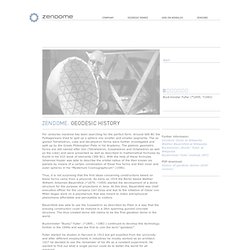
Around 600 BC the Pythagoreans tried to split up a sphere into smaller and smaller segments. The so gained Tetrahedron, cube and decahedron forms were further investigated and split up by the Greek Philosopher Plato in his Academy. The platonic geometric forms are still named after him (Tetrahedron, Icosahedron and Octahedron as well as the cube) and were presented as well as described in mathematical formulas by Euclid in his XIII book of elements (300 BC). With the help of these formulas Johannes Kepler was able to describe the orbital radius of the then known six planets by means of a certain combination of these five forms and their inner and outer spheres in his “Mysterium Cosmographicum” (1596). Thus, it is not surprising that the first ideas concerning constructions based on these forms came from a physicist. CommUnity of Minds » Blog Archive » Working Together. The Birth of The Geodesic Dome Lloyd Steven Sieden Although Buckminster Fuller invariably maintained that he was a comprehensivist who was interested in almost everything, his life and work were dominated by a single issue: shelter and housing.

Even as a young boy in the early 1900s, Fuller–who preferred to be called Bucky–was constructing rudimentary structures and inventing better “environment controlling artifacts.” The practical culmination of his quest to employ modern assembly-line manufacturing techniques and the best man-made materials in producing inexpensive, elegant housing came toward the end of World War II. At that time, government officials contracted Fuller to build two prototype Dymaxion Houses at the Beech Aircraft Company in Wichita, Kansas. The lightweight, circular houses were praised by all who toured them. Architecturebuckminsterfuller. Marta Herford Goebenstraße 4-10 + 49(0)52 21-99 44 30-0 Herford Bucky Fuller & Spaceship Earth June 11-September 18, 2011 Born in 1895 into a distinguished family of Massachusetts, which included his great aunt Margaret Fuller, a feminist and writer linked with transcendentalist circles of Emerson and Thoreau, Richard Buckminster Fuller Jr. left Harvard University, where the Fuller men had studied since 1740, to become an autodidact and earn a living by doing odd jobs.
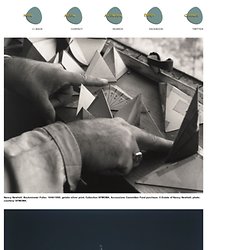
After marrying Anne Hewlett and serving in the Navy during World War I, he worked for his architect father-in-law at a company that manufactured reinforced bricks. The company went under in 1927, and Fuller set out on a year of isolation and solitude, during which time he nurtured many of his ideas — such as four-dimensional thinking (including time), which he dubbed 4D — and the search for maximum human benefit with minimum use of energy and materials using design. Ford Rotunda Dome. Henry Ford's grandson wanted to have a dome built to cover the open courtyard of the Rotunda Building at Ford's River Rouge plant.
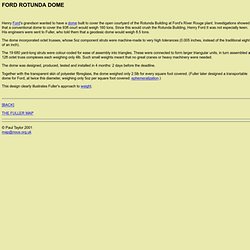
Investigations showed that a conventional dome to cover the 93ft court would weigh 160 tons. Since this would crush the Rotunda Building, Henry Ford II was not especially keen. His engineers were sent to Fuller, who told them that a geodesic dome would weigh 8.5 tons. The dome incorporated octet trusses, whose 5oz component struts were machine-made to very high tolerances (0.005 inches, instead of the traditional eighth of an inch).
Bucky in the Navy. On connaît tous les dômes géodésiques de Buckminster Fuller au succès mondial.

Beaucoup ont vu, non sans un certain étonnement la première fois, les images de la Dymaxion Car ou de la Dymaxion House. Mais ce qui est un peu moins connu, c’est le rôle qu’eut son passage à la US Navy dans l’œuvre du créateur. Inventeur, architecte, designer, théoricien, cartographe, enseignant, activiste environnemental avant l’heure, Buckminster Fuller (1895-1983) refusait tout cloisonnement des disciplines. Buckminster Fuller’s Dymaxion House. Cahill map vs Dymaxion Map. Buckminster Fuller : le World Game comme projet de société. « À l’occasion d’un premier World Game avec des étudiants de New York, en 1969, je leur ai soumis ce problème de réseau [énergétique] à l’échelle mondiale.
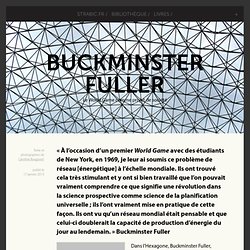
Ils ont trouvé cela très stimulant et y ont si bien travaillé que l’on pouvait vraiment comprendre ce que signifie une révolution dans la science prospective comme science de la planification universelle ; ils l’ont vraiment mise en pratique de cette façon. Ils ont vu qu’un réseau mondial était pensable et que celui-ci doublerait la capacité de production d’énergie du jour au lendemain. » Buckminster Fuller Dans l’Hexagone, Buckminster Fuller, incessant concepteur et visionnaire fascinant, est victime d’une faible diffusion, privant le lecteur francophone d’une pensée du design et de la société particulièrement stimulante.
Heureusement, les pointues éditions B2 se sont données pour mission de diffuser certains textes qui ont irrigué les campus américains. World Game with the Spaceship Earth. The nano's world of Buckminster Fuller. I.

Bucky Earth - mémoire allemand. Bucky Earth.
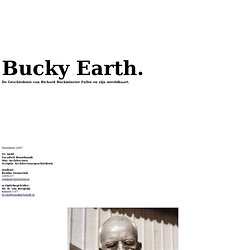
De Geschiedenis van Richard Buckminster Fuller en zijn wereldkaart. November 2007 TU Delft Faculteit Bouwkunde Msc Architecture Scriptie Architectuurgeschiedenis student: Remko Siemerink remko@viernulvier.nl scriptiebegeleider: Dr. Kabinet 5.07 H.vanBergeijk@tudelft.nl “I did not set out to design a house that hung from a pole, or to manufacture a new type of automobile, invent a new system of map projection, develop gesodesic domes or Energetic Geometry. R. Inhoudsopgave. 1 Inleiding. 3 1.1 Mijn kennismaking met het fenomeen Fuller. 4 1.2 De scriptie. 11. Blog Bradley Dice. Background images: (Design Museum), (McKeough), (Langley) Signature: (Fuller, Buckminster Fuller: An Autobiographical Monologue/Scenario 216) Primary Sources Baldwin, Jay.

BuckyWorks: Buckminster Fuller's Ideas for Today. New York, NY: John Wiley & Sons, Inc., 1996.